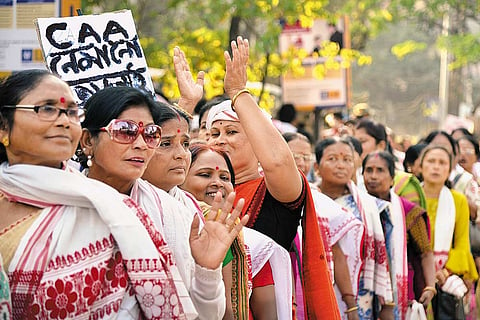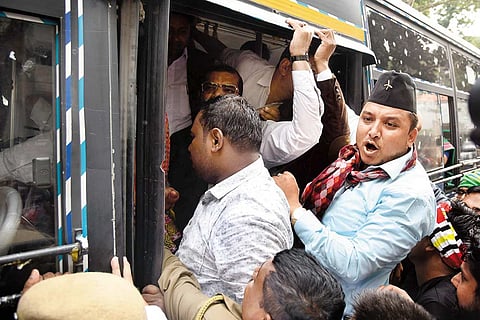The past often provides vital context to present turmoil. In the Northeast, discontent in one part often holds great significance for others; the same story invariably plays out in another, more virulent, form. This February, widespread violence convulsed Arunachal Pradesh after the state government decided to issue permanent resident certificates to six non-Arunachalee communities, most of them from neighbouring Assam. The certificate would have made these people eligible for government jobs and admission to state-run schools and colleges. At least two people were killed in police firing and the residence of the deputy CM was razed; the government backed off, saying it will “not take up the matter” ever again.
In North-East India Why The Word 'Bangladeshi' Is Just Plain Evil
The Citizenship Amendment Act has scratched an old wound in a land where the hatred for the 'illegal immigrant' runs deep
The widespread, sometimes violent, protests against the Citizenship (Amendment) Act in Assam has to be read against the backdrop of what people in the Northeast fear most—loss of identity, jobs, resources. The common enemy is the “illegal immigrant”—a loaded word that carries political and social undertones. The CAA—short for the Citizenship (Amendment) Act—has set the cat among the pigeons once again, scratching an old wound that refuses to heal and churning discontent in a region where fear of and revulsion for the “Bangladeshi” runs deep. It’s a region where people of Arunachal would not cede an inch to the Assamese. And there were no objections from Assamese organisations, well aware as they are of Northeast’s identity complexities. The Assamese supported the National Register of Citizens (NRC), a contentious, error-filled process to update the citizenship records, opposed by many across the country as a tool to harass Muslims.

Ladies closed ranks against the CAA in Guwahati.
In the Northeast, the word “Bangladeshi” has no religion. It’s plain evil. That’s why it’s often difficult for those outside the region to understand the contradictions in the nature of anti-CAA protests in the Northeast, fundamentally different from those across the country. Assam’s protest doesn’t follow the Hindu-Muslim narrative that dominates the discourse across India—a point that Assamese leaders are trying to convey. “Our demand is simple…all Bangladeshis, irrespective of religion, caste or community, must be thrown out of our state,” says Samujjal Bhattacharyya, advisor to the influential All Assam Students’ Union (AASU).
The new act paves the way for granting citizenship to persecuted non-Muslims from neighbouring Afghanistan, Pakistan and Bangladesh, who have come to India till December 31, 2014. But Assam would have none of it, though in a new world order, newer sensibilities call for a more humane attitude towards immigrants and refugees. The genesis of Assam’s fear and anger lies in the past, in cataclysmic events that fractured lands and people (See The Politics of Birth, The Birth of Politics).
For four decades now, infiltration has dominated public discourse in Assam. A six-year mass movement—seen by many outside the state as Assamese xenophobia and racism—ended with the signing of the Assam Accord in 1985, but the issue festered owing to reluctance of successive AGP and Congress governments to act. The anti-CAA uprising in Assam is precisely for this reason—the people see the law as a betrayal by BJP, which have won successive elections in Assam since 2014 with the single agenda of detecting and deporting illegal immigrants. What the people of Assam had not bargained for was the BJP’s agenda of providing sanctuary to Hindu refugees. “We voted the BJP in the hope that they will respect our sentiments. But this party has turned out to be even worse than AGP and Congress,” says Binapani Saikia, 45, a homemaker, among thousands of protestors at Latasil in Guwahati on all three days during an AASU-led satyagraha.

A Gorkha protestor makes the point in motion.
For days after CAB became CAA, lakhs of people turned up at protests across Assam— a shouting, singing, heaving mass of people. For old-timers, it was a throwback to the days of the Assam agitation, which left 855 people officially “martyred”. In Sivasagar, people from all faiths gathered to sing zikirs—Kabir-style devotional songs praising both Ram and Allah, written in Assamese by Azaan Pir, a 17th century preacher from Baghdad. It was a way of showing the secular credentials of the anti-CAA movement. “It’s against the indigenous people. We have already faced an identity crisis after the migration of Bengali Muslims from across the border. Now with CAA, the indigenous people here face the threat of losing their identity. We are Assamese first, religion comes later,” says Hafizul Ahmed, who represents Assam’s indigenous Muslims—the Gorias and Morias. Samujjal Bhattacharyya is specific about the movement’s ideology. “Contrary to what many believe, we are not anti-Muslim, not anti-Bengali, not anti-Hindu…we are anti-Bangladeshi,” he says. Protestors point out that among the five dead in police firing on demonstrators are a Muslim and a Christian.
The region’s substantial Bengali Hindu population looks at any such movement with suspicion and trepidation. There is a reason. The Bengalis have faced violent backlash in Assam and Shillong, often accused of what many refer to as “settler colonisation”. Tripura is often cited as a case when refugees became the “lord and master” over the natives. Sukumar Biswas, president of a joint platform representing 14 Bengali organisations in Assam, says they support CAA only in the hope that it will end the harassment. “We support CAA but we don’t want Bangladeshi Hindus to come and settle in Assam. We hope Bengali Hindus left out of NRC and forced into detention camps get to be known as Indians,” says Biswas, a postgraduate in Assamese literature.
The BJP sees Muslim settlers as the problem. Assam minister Himanta Biswa Sarma appeared to be driving this narrative during a press briefing in Guwahati, highlighting Muslim-sounding names of people arrested. Skirting tricky questions, he steered the conversation towards identifying “third forces” behind the violence—hinting at Congress, a party he was with before joining BJP. Still, protestors single out Sarma and CM Sarbananda Sonowal as traitors. “The other states in the Northeast managed to ring-fence themselves against CAA. They either have protection under the Sixth Schedule or have inner-line permit,” says Jyotsna Kalita, an intern with a Hyderabad-based company. “Even Manipur got the ILP…but what did Sarbananda and Himanta do for Assam? Lay out the red carpet for more Bangladeshis?” Another protestor, Amar, was equally scathing: “No political party, not even AGP, respects our sentiments.”
It’s in this context that talks of a political alternative sprang up, an idea that found favour with popular singer Zubeen Garg. Hiranya Kumar Bhattacharyya, retired IPS officer and former DIG of Assam police, says it’s not the right time for a new political party as vested interests will enter the space. “The agitation’s objective must be achieved…there is no other option,” he adds. The AGP appeared to be clueless as it voted for the bill in Parliament and then filed a plea in the Supreme Court, one among 59 writ petitions against CAA. Former chief minister Tarun Gogoi picked up his lawyer’s robe after 36 years to plead against the act in the top court. He is 85.
How many Hindus are likely to seek Indian citizenship under CAA? The Assamese believe it could be 10 million; Himanta Biswa Sarma says less than 550,000. How are the numbers calculated? Nobody says/knows. In Assam, when it comes to illegal immigrants, individual estimates become the gospel truth. When the NRC left out 1.9 million people, Assamese groups, including AASU, rejected the “small numbers”. The BJP rejected it for another reason. There were apparently too many Hindus on the exclusion list. In the order of the universe, B comes after A. CAB becoming CAA changes the order. But Assam has always been a story is reverse.
By Anupam Bordoloi in Guwahati with inputs from Abdul Gani